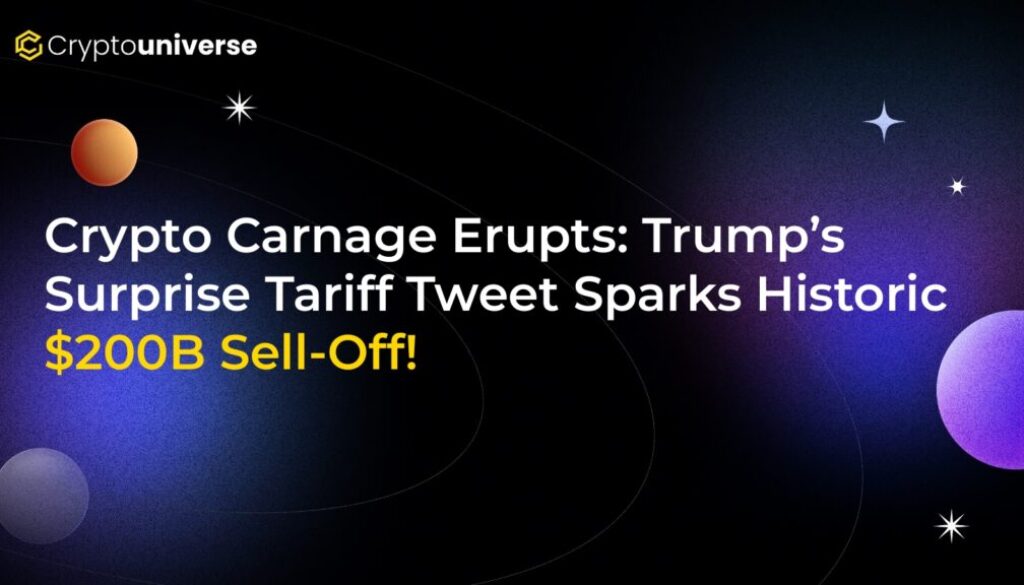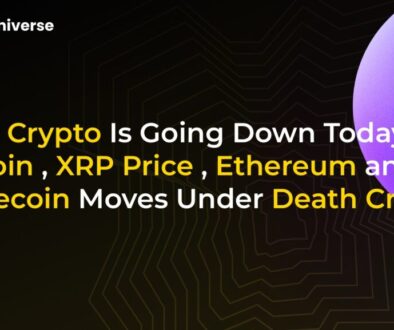Crypto Carnage Erupts: Trump’s Surprise Tariff Tweet Sparks Historic $200B Sell-Off!

A Single Tweet Ignites a Firestorm in Global Markets
On the evening of Friday, October 10, the financial world was rocked by a single, unexpected social media post. Former President Donald Trump announced on Truth Social his intention to impose a staggering 100% tariff on all Chinese imports, effective November 1. The announcement blindsided investors and triggered an immediate and brutal “risk-off” cascade across global markets. While stocks tumbled, the cryptocurrency sector bore the brunt of the panic, experiencing one of its most violent sell-offs in history. The event triggered what’s being called a historic <$200B Sell-Off!>, wiping out billions in value in a matter of hours.
The Crypto Crash by the Numbers: A Record-Breaking Liquidation Event
The reaction in the crypto markets was instantaneous and catastrophic. Bitcoin, which had been trading comfortably around $122,000, plummeted to a low of nearly $104,782 by the next day—a painful 14% plunge. Ethereum wasn’t spared, dropping over 12% to fall below the $3,500 mark. But the real devastation was felt in the highly leveraged derivatives market.
According to data from CoinGlass, the sudden price drop triggered a massive wave of liquidations. In just 24 hours:
- $19.1 billion in leveraged positions were wiped out.
- Over 1.6 million traders were forced out of their positions.
- One exchange reported a single liquidation of an Ether position worth $203 million.
The sheer volume of trades and margin calls overwhelmed major exchanges like Binance, which experienced technical issues and slowed withdrawals. The event was reportedly nine times larger than the February 2025 crash, dwarfing even the market panic seen during the COVID-19 outbreak in 2020.
Altcoins Bleed as Institutions Flee to Safety
While Bitcoin and Ethereum led the downturn, altcoins suffered an even more severe fate. As institutional investors rushed to protect their core holdings, they pulled capital from smaller, more speculative assets. This created a liquidity vacuum, causing extreme price swings for many tokens.
The damage was widespread:
- XRP flash-crashed by approximately 31%.
- Binance Coin (BNB) tumbled around 20%.
- Dogecoin plummeted by a staggering 39%.
Many other smaller tokens saw intraday losses ranging from 50% to 80%, and crypto-linked stocks like Coinbase (COIN) also dropped by as much as 8%.
Not Just a Crypto Problem: A Global Market Meltdown
The tariff threat didn’t just rattle the digital asset space; it sent tremors through the entire global financial system. The S&P 500 and Nasdaq experienced their worst single-day drops in months, with an estimated $2 trillion vanishing from stock market valuations. European and Asian markets followed suit, sinking on fears of a renewed and intensified trade war.
Investors fled to traditional safe-haven assets. Gold soared to a record high of around $4,000 per ounce, and long-term U.S. Treasuries rallied. The episode demonstrated that crypto, despite its “digital gold” narrative, traded in lockstep with other risk assets like tech stocks during a widespread panic.
The Mysterious Traders Who Timed the Crash Perfectly
Amid the widespread financial devastation, a fascinating subplot emerged. On the decentralized futures platform Hyperliquid, two traders placed enormous short bets against Bitcoin and Ethereum just minutes before Trump’s post went live. They reportedly closed their positions for a combined profit of approximately $160 million.
The impeccable timing raised suspicions of a potential leak. However, investigators noted that the trades were placed shortly after China announced its own restrictions on rare-earth exports—the very move that likely prompted Trump’s tariff threat. While no evidence of illicit activity has surfaced, the incident highlights the high-stakes, high-volatility environment traders are navigating.
A Weekend of Uncertainty and a Fragile Rebound
Over the weekend, President Trump attempted to calm the markets he had roiled, posting that “it will all be fine” and that the U.S. did not want to harm China. This brief de-escalation helped both stocks and crypto stage a modest recovery by Monday, with Bitcoin climbing back above $115,000.
However, the relief was short-lived. By October 14, renewed fears surfaced after China announced new sanctions, sending Bitcoin back below $112,000 and triggering another $630 million in liquidations. The market remains on a knife’s edge, highly sensitive to every new geopolitical development.
The Silver Lining: Has the Market Been Cleansed?
Some industry analysts see a positive side to the brutal sell-off. Nic Puckrin of Coin Bureau remarked, “The good news is that this crash has cleaned out the excessive leverage and reset the risk in the market, for now.” The rout exposed the dangerous levels of leverage that had fueled the market’s multi-month rally, and this reset could pave the way for a healthier, more sustainable recovery.
Not everyone is convinced the worst is over. Veteran investor Robert Kiyosaki warned that “bubbles are about to start busting,” cautioning that both Bitcoin and gold could see a 50% drawdown before a new rally begins. On the other hand, on-chain analyst Willy Woo noted that capital seemed to be rotating into Bitcoin from altcoins rather than leaving the crypto ecosystem entirely. Some bulls even see this as a prime buying opportunity, predicting Bitcoin could reclaim highs of $130K–$160K by late 2025 if geopolitical stability returns.
Conclusion: Crypto’s Geopolitical Awakening
The mid-October turmoil has delivered a crucial lesson: cryptocurrency is no longer an isolated asset class immune to real-world events. Its fate is now inextricably linked to geopolitics, monetary policy, and global risk sentiment. The dream of Bitcoin as a pure safe haven has been challenged; in a crisis, it behaves like a high-beta risk asset.
As trade tensions simmer and global uncertainty persists, volatility is likely to remain a defining feature of the crypto market. The October 2025 crash will be studied for years as a critical stress test of the digital asset ecosystem. For now, investors are left watching the charts, the headlines, and the social media feeds of world leaders, waiting for the next catalyst to move the market.


